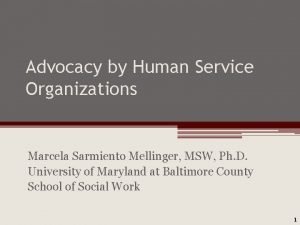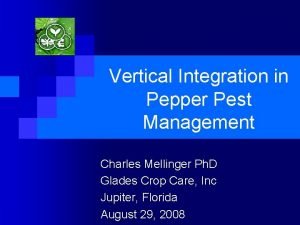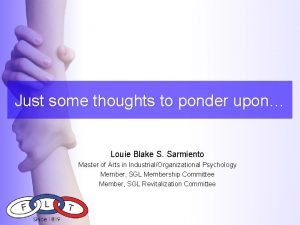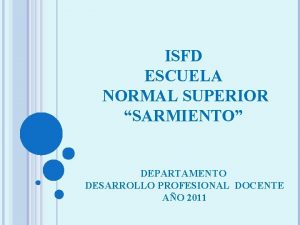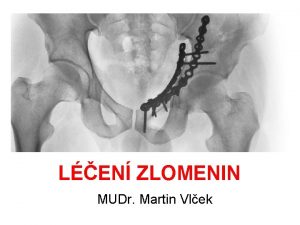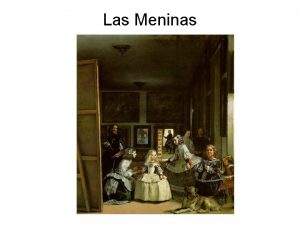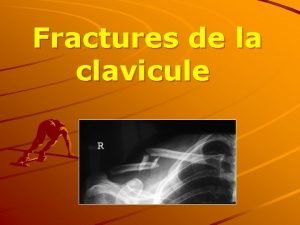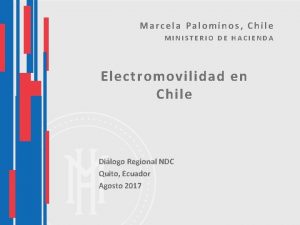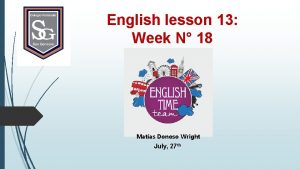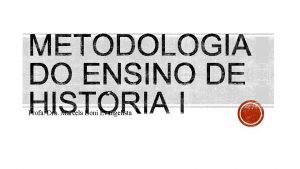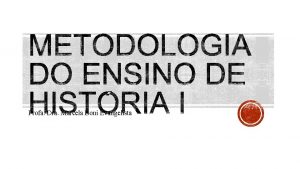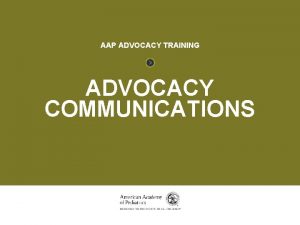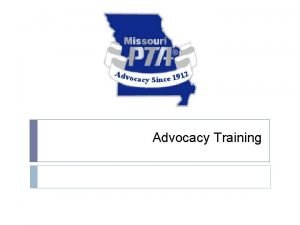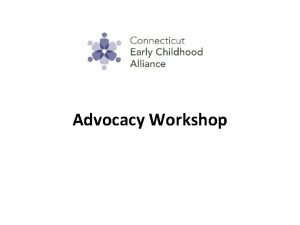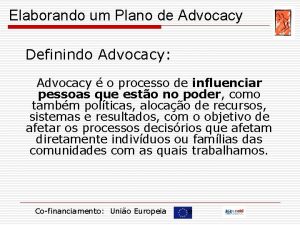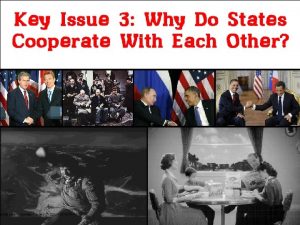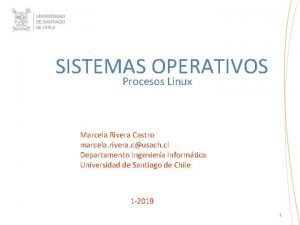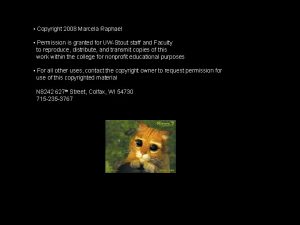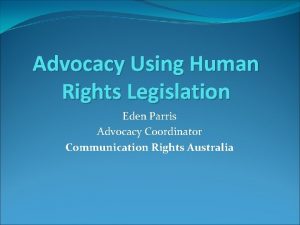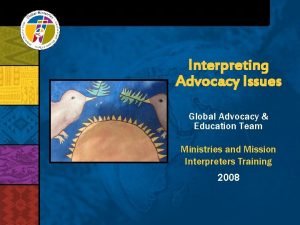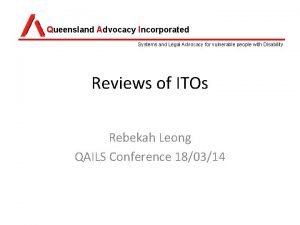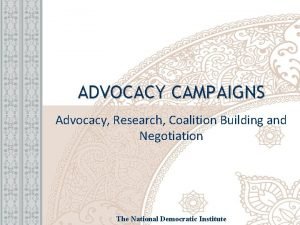Advocacy by Human Service Organizations Marcela Sarmiento Mellinger

Advocacy by Human Service Organizations Marcela Sarmiento Mellinger, MSW, Ph. D. University of Maryland at Baltimore County School of Social Work 1

Should human service leaders be involved in advocacy? Advocacy? When? How? At what level? Who should be the target? 2

Nonprofits Nonprofit Sector • Has been recognized by experts as a vital part of social, economic, political development of modern society • Service provision and advocacy are two of the functions of human service NPOs identified in the literature (Kramer, 1981; Salamon, 2002) 3

Advocacy • Action taken on behalf of a group • Goal is broad level change • Through advocacy, human service nonprofit organizations (NPO) have: ▫ Identified social problems ▫ Protected basic human rights ▫ Provided a voice to social, political, cultural, and community affairs ▫ Acted as critics and guardians to bring about change 4

Review of the Literature • No agreement on one definition of advocacy ▫ Emphasis on different aspects of advocacy depending on context • Points of agreement: ▫ Advocacy: intervention on behalf of others ▫ Macro or cause advocacy: action taken on behalf of a group of people ▫ Micro or individual advocacy: action taken on behalf of one person or family ▫ Advocacy: active not passive • Advocacy as a political activity is the most commonly used definition 5

Review of the Literature • Most research includes only legislative advocacy ▫ Is intervention at other levels advocacy? • Scope of advocacy participation ▫ Studies yield conflicting findings ▫ Organizations are believed to participate in advocacy but intensity of participation is unclear ▫ Activities utilized seen as peripheral 6

Review of the Literature • Structure of advocacy among organizations ▫ Conceptually important, but there is a lack of systematic research • Advocacy Targets ▫ Advocacy is a broad concept that includes legislative advocacy but also advocacy at other levels (Ezell, 2001) �Administrative �Legal �Community 7

Review of the Literature Factors that influence advocacy Funding and resources Environmental changes and political climate Organization’s mission Membership in coalitions and associations Tax laws Professionalization 8

Purpose of Study • Explore institutional factors that influence advocacy behavior of human service nonprofit organizations • Where? ▫ Northeast Georgia region • Regarding: ▫ Overall advocacy participation ▫ Structure of advocacy ▫ Targets of advocacy 9

Conceptual Framework Control variables Institutional variables • Organizations’ size • Organizations’ age • • Formalization Professionalization Funding Tax laws Advocacy • Overall advocacy participation • Advocacy structure • Advocacy targets 10

Study Type Design • Quantitative • Explanatory-descriptive • Cross-sectional 11

Sample • • Availability or convenience sample Northeast Georgia Region Sample size = 72 organizations Sampling criteria: ▫ 501(c)3 NPOs ▫ Provide assistance to promote individual, social, economic, and psychological well being ▫ Excluded: strictly medical and educational organizations 12

Procedure • Self administered electronic survey ▫ One time administration • Survey construction based on literature and practice wisdom 13

Descriptive statistics – Sample Characteristics Variable Type of NPO Age of organization (years in operation) Total annual budget (size) Budget categories Value Non-faith-based Faith-based Range 1 -187 Number (%) 63 (87. 5%) 9 (12. 5%) 32. 1 (32. 5) Range $11, 980 $15, 000 Small < $500, 000 Mean (SD) $2, 144, 288 (3796947) 41 (57%) Medium $500, 001 - 16 (22. 2%) $3, 000 Large > $3, 000, 001 15 (20. 8%) 14

15 Results: Predictor Variables Variable Value Formalization Range: 0 - 5 Number (%) Mean (SD) 4. 2 (1. 2) Clinical identity Yes No 8 (11. 1%) 64 (88. 9%) Funding Restricted Unrestricted 45 (33. 3) 55 (33. 3) Knowledge of Range: 0 - 8 the law 4. 3 (2. 5)

16 Results: Outcome variables Advocacy participation • Yes • No 65% (47) 35% (25) Advocacy Structure • Yes • No 65% (47) 35% (25) Advocacy Targets • • • Legislators – federal Legislators – state Legislators – local Administrators (agency) Legal Community Mean (SD) (Range 0 -4 ) 0. 8 (0. 95) 1. 2 (1. 1) 1. 1 (1. 0) 1. 5 (1. 3) 0. 6 (0. 9) 1. 6 (1. 1)

Results Target Frequency of advocacy participation Percentage Legislative Federal Never Extremely Low Medium High 22. 9% 50% 14. 3% 7. 1% 5. 7% Legislative State Never Extremely Low Low Medium High 22. 9% 37. 1% 14. 3% 21. 4% 4. 3% 20% 37. 1% 21. 4% 17. 2% 4. 3% Legislative Local 17

Results Target Agency Legal Community Frequency of advocacy participation Never Extremely Low Low Medium High Never Extremely Low Medium High Percentage 21. 4% 20% 18. 6% 27. 1% 12. 9% 48. 6% 32. 9% 11. 4% 2. 8% 4. 3% 21. 4% 10% 32. 9% 24. 3% 11. 4% 18

What Was Predicted? Overall Advocacy Participation • Knowledge of the lobbying law predicted advocacy participation • Relationship between variables was negative 19

What Was Predicted? Structure of Advocacy • Formalization predicted structure of advocacy • Relationship between variables was positive 20

What Was Predicted? Targets of Advocacy • Knowledge of lobbying law predicted all targets except legal (courts) ▫ Relationship between variables was positive • Restricted funding only predicted legislative advocacy at the state level • None of the predictor variables predicted legal advocacy 21

Limitations • Advocacy definition was given to participants • Non-random sample • Lack of instruments to measure advocacy targets. Scales used were new • Low response rate (72 cases out of 435) • Topic—potential fear of addressing an area that may be perceived as a threat to survival • Length of survey may have decreased participation 22

Implications - Practice • Increased visibility for NPOs within community • Increased legitimacy for NPOs within community • A seat at decision making table and a voice when decisions are made ▫ At public policy level and beyond • Administration issues: ▫ Staffing ▫ Training (staff and board) ▫ Resources 23

Implications - Policy • Increased visibility of NPOs where policies are implemented • A voice to the disadvantaged that should not be silenced - ability to inform public policy • Relationships with those in positions of authority • Exploration of advocacy beyond the legislative level 24

25 How Much (lobbying) Can We Do? • It depends! Are you advocating or lobbying? ▫ At what level, federal, state, or local? ▫ Which target, legislative, agency, legal, or community? • Federal level has regulations for lobbying ▫ The “substantial rule” ▫ The “H elector” rule or “expenditure test” �Limits on expenditures are based on a formula ▫ IRS form 5768

26 A bit about lobbying • The substantial rule is not specific (in the law since 1934) • The law does not say that NPOs cannot speak out regarding public policy, but it does say they cannot lobby “substantially” • In reality, legislators need to and should interact with NPO leaders • Communication for educational purposes is not considered lobbying • Testifying or offering advice is not considered lobbying • This only applies to the legislative branch of government ▫ Going to the executive branch or judicial branch is not covered by the law

27 H electors • If an H elector, the NPO is no longer governed by the “substantial rule” • Part of the Tax Reform Act of 1976 • Two sliding scale formulas ▫ Direct lobbying of legislators �NPOs with budgets of up to $500, 000 can spend 20% of all their expenditures on direct lobbying �NPOs with budgets $1. 5 -$17 million, can spend $225, 000 + 5% of the budget over $1. 5 million ▫ Grass-roots lobbying �Allows NPOs to spend up to one fourth of the total allowable lobbying expenditures

What to do • Partisan political action violates the law ▫ No endorsement of candidates for public office ▫ Do not use government funds to lobby congress • It is alright to: ▫ Focus your efforts on policy and regulation changes ▫ Focus on clarifying or seeking change of governmental roles and responsibilities ▫ Bring awareness of public interest issues ▫ Educate legislators, administrators, judges, and community leaders ▫ Develop relationships 28

“Nonprofit organizations can and should lobby. It isn’t difficult. It isn’t mysterious. It isn’t expensive. It is not an unnatural act. It is a responsibility to those we serve and support, and it is a proper role for nonprofits. ” Ron Cretaro, CAN Executive Director, and Marcia Avner, Director of Public Policy, Minnesota Council of Nonprofits 29

References • Boris, E. T. , & Mosher-Williams, R. (1998). Nonprofit advocacy organizations: Assessing the definitions, classifications, and data. Nonprofit and Voluntary Sector Quarterly, 27, 488 -506. • Donaldson, L. P. (2008). Developing a progressive advocacy program within a human services agency. Administration in Social Work, 32, 25 -48. • Ezell, M. (2001). Advocacy in the human services. Belmont, CA: Brooks/Cole. • Frumkin, P. , & Galaskiewicz, J. (2004). Institutional isomorphism and public sector organizations. Journal of Public Administration Research and Theory, 14, 283 -307 30

References • Gibelman, M. , & Kraft, S. (1996). Advocacy as a core agency program: Planning considerations for voluntary human service agencies. Administration in Social Work, 20, 43 -59 • Kramer, R. M. (1981). Voluntary agencies in the welfare state. Berkeley, CA: University of California Press. • Leiter, J. (2005). Structural isomorphism in Australian nonprofit organizations. Voluntas: International Journal of Voluntary and Nonprofit Organizations, 16, 1 -31 • Mosley, J. E. (2006). The policy advocacy of human service nonprofits: How institutional and environmental conditions shape advocacy involvement. Unpublished doctoral dissertation. Los Angeles, CA: University of California Los Angeles. 31

References • Ruef, M. M. , & Scott, W. R. (1998). A multidimensional model of organizational legitimacy: Hospital survival in changing institutional environments. Administrative Science Quarterly, 43, 877 -904. • Salamon, L. M. (2002). The state of nonprofit America. Washington, DC: Brookings Institution Press. • Schneider, R. L. , & Netting, F. E. (1999). Influencing social policy in a time of devolution: Upholding social work's great tradition. Social Work, 44, 349 -357. • Scott, W. R. (2001). Institutions and organizations. Thousand Oaks, CA: Sage Publications, Inc. • Taylor, E. D. (1987). From issue to action: An advocacy program model. Lancaster, PA: Family Service. 32
- Slides: 32
